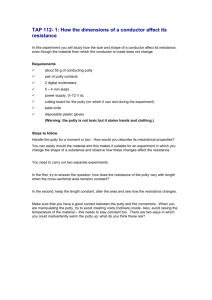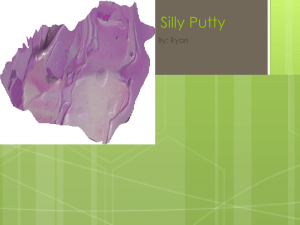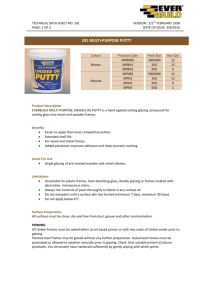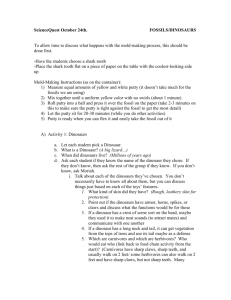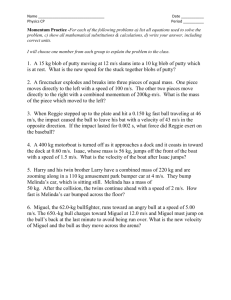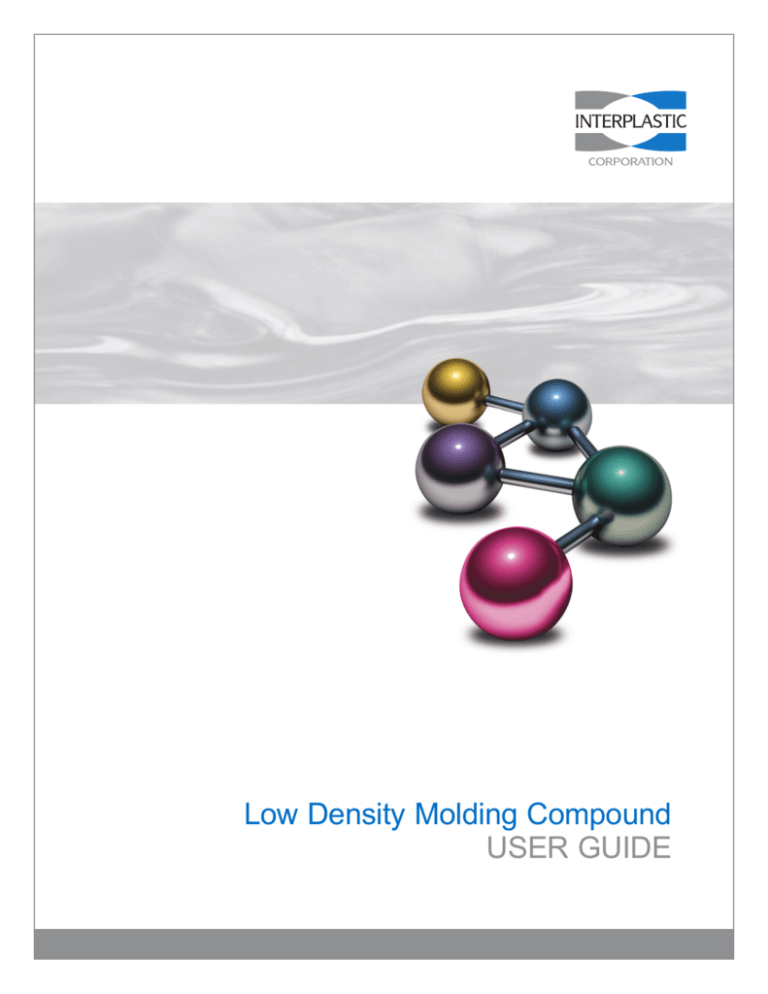
Low Density Molding Compound
USER GUIDE
COR-Grip®
LOW DENSITY MOLDING COMPOUND
Interplastic bonding putties are formulated for hand mixing or machine application. Consistent and uniform blending of the initiator is necessary for optimum performance. When using bonding putties, be sure
to clamp or push down firmly to rid the putty of air voids for better strength and adhesion. Do not over
tighten the clamps and flex the mold because that can build internal stresses that may cause defects
and/or failure.
The strength, performance and durability of a putty bond is determined by the type of bond, the properties of the putty, the performance of the materials being bonded and how that bond is assembled.
Best Practices for Handling Incoming Putty:
1. Check the incoming certificate of analysis to ensure the product and lot number match the received
containers.
2. Check the quality control data to your required specifications.
3. Rotate and use your putty stock, first in, first out. Storing material above 90°F or below 65°F may affect the shelf life as well as the viscosity and gel time stabilities of the putty.
*NOTE: Please refer to the Safety Data Sheets for safe storage and personal protective equipment. Read and understand the application equipments user manuals before operating.
Container Set-up:
1. Acclimate the containers to be used by placing them near the assembly area or in the same room a
few days before using. This will bring the putty to ambient operating temperatures.
2. Ensure the containers label identifies the correct putty and is the same as the container that is being
replaced.
3. Check the container for leaks, cracks or dents that may prevent the plunger ram of the pump from
lowering all the way to the bottom of the drum.
4. When the lid is removed, inspect the lid for gelled particles, stalactites and separation at the surface
of the putty. If there are issues, report them. It may be necessary to set the drum aside and use a different drum until the issues can be addressed.
Before building parts with Low Density Molding Compound (LDMC), ensure the core materials are sized
and cut to fit the parts recesses. Be certain the core materials contour to the corners of the build. The
starting point for the following suggestions are with a two part recessed and bulging mold system where
gel coat and a skin coat have been applied and allowed to cure before using the LDMC.
PS-100-PMLN LDMC - Its primary use is in the manufacturing of cored, flat, laminated fiberglass parts
with gel coated surfaces on both sides. LDMC is engineered to offer better bonding with superior structural improvement to parts as well as lowering the overall weight compared to standard fiberglass composites that were made with an open molding, RTM, cold molded or infusion process.
800.736.5497 • 651.481.6860 • www.interplastic.com
USER GUIDE
Attributes of Interplastics PS-100-PMLN include:
• Superior adhesion: the compound bonds to the laminate and the core material
• Free flowing: the compounds viscosity allows it to be poured and flows easily to displace voids in the
part when compressed
• Structural strength: formulated with high performing resins with high elongation properties
• Weight reduction: lighter than conventional two sided molded parts with comparable rigidity
Compared to RTM/infusion methods, the benefits of using LDMC are:
• Less manufacturing equipment is required (pumps, hoses, bags)
• Reduced weight in the finished part
• Less finishing work at the edges
• Less laminator training required
Using Low Density Molding Compound to build small parts. *For Reference Only.
Step 1: Squish molds are normally a two piece
set (male and female). Pictured here on the
left is a bow hatch cover. These molds are
prepped and masked for typical gel coat
application.
Step 2: The molds are sprayed to the desired gel
coat thickness and the tape lines are
pulled. The gel coat is allowed to cure.
COR-Grip® LOW DENSITY MOLDING COMPOUND
Using Low Density Molding Compound to build small parts. (continued)
Step 3: After the gel coat has cured, a skin coat with
a standard laminating resin is applied.
Pictured on the left, one layer of 1.5 oz of
continuous mat has been applied. The skin
coat is allowed to cure.
*Note: We suggest 20 barcol reading with a
Barber Coleman 934 impressor gauge
before proceeding.
Step 4: The LDMC is initiated with 1.5% by weight
Methyl Ethyl Ketone Peroxide (MEKP)
(9% active oxygen). For optimal results,
ensure the MEKP is fully dispersed
throughout the putty by using a paddle
attachment with a pneumatic drill. A
peroxide with a fading color allows the
operator to visually see how well the
peroxide is dispersed.
Step 5: The desired amount of initiated LDMC is
poured into the laminated female mold, only
allow it to flow half the distance from the
center of the side wall to the inside edge of
the flange.” This ensures the pre-fitted core
(high density structural foam, scribed balsa,
honey comb, etc.) will sit in the middle of
the LDMC mass.
800.736.5497 • 651.481.6860 • www.interplastic.com
USER GUIDE
Using Low Density Molding Compound to build small parts. (continued)
Step 6: Using a brush, spread the LDMC over the
entire part ensuring the LDMC is applied
in the corners and recesses of the gel
coated part. To help eliminate air next to the
gel coat use a brushing motion that will not
incorporate bubbles into the LDMC mass.
Step 7: After bedding the core material into the first
pour of LDMC, a second amount is poured
on top of the core material. The desired
volume should be poured so it is just short
of the inside edge of the molds flange. This
will allow for some flow and displacement
of air when the male mold is placed on top
and compressed. The key is to use enough
LDMC to fully fill every void and push out
any entrapped air without having too much
excess squeezed out of the part. Ensure all
air is displaced with LDMC before
continuing. Masking the edges will aid in
clean up and mold protection.
Step 8: The male mold is flipped and placed into the
female mold. The male mold is wiggled
slightly to help in the removal of entrapped
and excess air. The part is then clamped or
compressed by other means where the
extra LDMC and air is expelled.
COR-Grip® LOW DENSITY MOLDING COMPOUND
Using Low Density Molding Compound to build small parts. (continued)
Step 9: After the part is fully cured, the parts are
unclamped and pulled (demolded).
Step 10: The parts are trimmed and ready for
assembly.
Observations:
• Know the volume of LDMC mixture required to construct a part. Measure the displacement voids and
subtract the area of the core panel, if a core is being used. Add slightly more LDMC mixture to the
part than is required.
• LDMC is for the construction of noncomplex, low geometry parts. Under compression, the LDMC mixture will flow to the areas of least resistance, which should be the flanges.
• Keep LDMC casting to under 3/4”. There may be higher exotherm reactions and greater shrink characteristics with larger masses which might distort the part.
• A slight amount of LDMC mixture overflowing from the flanges during compression is required to ensure a void free part.
• Low pressures are required to fully compress the parts until they are clamped.
• When adding initiator, use methods and equipment that minimize the incorporation of air bubbles into
the mixture.
• LDMC mixture is self-leveling. To avoid unnecessary draining and uneven parts, apply only to horizontally aligned parts.
800.736.5497 • 651.481.6860 • www.interplastic.com
USER GUIDE
Resin
COR-Grip® Marine/General Putty Products
Application
PA-160-PMMN Non-Reinforced Bonding/Adhesive Putty
- Mid Density
PA-805-PLML Non-Reinforced Bonding/Adhesive Putty
- Light Weight
PA-150-PHHN Reinforced Bonding/Adhesive Putty
Gel Time*
(min:sec)
25:00 - 35:00
50:00 - 65:00
20:00 - 30:00
PB-200-PULN
Light Weight Bedding Putty
20:00 - 30:00
PF-410-PLMF
Fairing Putty
2:30 - 5:15
PR-600-PMMN Reinforced Fillet Putty
20:00 - 30:00
PR-650-PMMN Light Weight Fillet Putty
20:00 - 30:00
PC-900-PULN
20:00 - 30:00
Ceramic Transom Putty
PS-100-PMLN Low Density Molding Compound
28:00 - 42:00
Viscosity
525,000 - 650,000
RV T-E @ 5 rpm
375,000 - 600,000
RV T-E @ 5 rpm
1,000,000 - 1,400,000
RV T-F @ 5 rpm
60,000 - 80,000
RV T-B @ 5 rpm
400,000 - 500,000
RV T-E @ 5 rpm
275,000 - 400,000
RV T-E @ 5 rpm
275,000 - 400,000
RV T-E @ 5 rpm
8,000 - 10,000
RVT #5 @ 20 rpm
1,000 - 4,000
RVF #4 @10 rpm
COR-Grip® Corrosion Putty Products
PA-170-PMHN Isophthalic Corrosion Bonding/Adhesive
Putty
PA-180-VHMN Vinyl Ester Corrosion Bonding/Adhesive
Putty
PA-196-PHLN
20:00 - 30:00
20:00 - 30:00
1,000,000 - 1,400,000
RV T-F @ 5 rpm
275,000 - 400,000
RV T-E @ 5 rpm
COR-Grip® Fire Resistance Putty Products
Fire Resistance Bonding/Adhesive Putty
20:00 - 30:00
120,000 - 200,000
RV T-E @ 5 rpm
Low Density Molding Compound
User Guide
All specifications and properties listeded above are appropriate. Specifications and properties of material delivered may vary slightly from
those given. Interplastic Corporation makes no representations of fact regarding the material except those specified above. No person has
any authority to bind Interplastic Corporation to any representation except those specified above. Final determination of the suitability of the
material for the use contemplated is the sole responsiblity of the Buyer. Interplastic Corporations sales representatives are available to assist
in developing procedures to fit individual requirements.
1225 Willow Lake Blvd., St. Paul, MN 55110-5145
800.736.5497 • 651.481.6860 • Fax: 651.481.9836
www.interplastic.com
© 2014 Interplastic Corporation. All rights reserved. CoREZYN and COR-Grip are registered trademarks of Interplastic Corporation. Printed in USA 5/14

